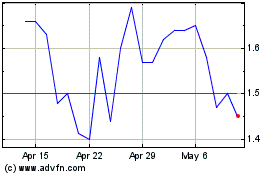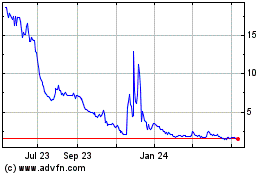Altamira Therapeutics Announces Publication of Preclinical Data Showing Successful Treatment of Abdominal Aortic Aneurysm with SOD2 mRNA Delivered by SemaPhore Nanoparticles
19 July 2024 - 11:01PM

- Study shows significant reduction in aorta dilation, delayed
rupture and lower mortality in established animal model of
abdominal aortic aneurysm
- Altamira’s SemaPhore™ nanoparticles delivering SOD2 mRNA
successfully to mitochondria in aorta wall
- Positive outcomes suggest potential use of treatment in
management of small abdominal aortic aneurysm and prevention of
ruptures
Altamira Therapeutics Ltd. (“Altamira” or the
“Company”) (Nasdaq:CYTO), a company dedicated to developing and
commercializing RNA delivery technology for targets beyond the
liver, today announced the preprint publication of a study
demonstrating effective treatment of abdominal aortic aneurysm
(AAA) in an animal model.1 The study was conducted by a research
group from Washington University, St. Louis MO, and the University
of South Florida, Tampa FL. It showed that treatment with SOD2 mRNA
delivered systemically with peptide-based nanoparticles (SemaPhore™
by Altamira) to AAA mice resulted in a significant reduction in
aorta dilation (p<0.05), delayed rupture and a highly
significant improvement in survival rates (p<0.01) compared to
untreated controls.
AAA is a localized abnormal enlargement (bulge)
of the abdominal aorta, i.e. the part of the main artery which runs
through the belly. The rupture of an AAA may be life-threatening;
more than 50% of patients die before they reach the emergency room,
and those who survive have very high morbidity.2 The prevalence of
AAAs increases with age and is 4-6 times more common in men than in
women; it develops in approximately 1% of men between 55 and 64
years of age, and increases by 2 to 4% per decade thereafter.3
Surgery is the main treatment for large AAAs or those that are
growing rapidly.
AAA is an inflammatory disease involving
oxidative stress caused by excessive levels of reactive oxygen
species (ROS). Although the use of antioxidants would appear a
promising treatment strategy, clinical efficacy has turned out to
be mostly unsatisfactory. By targeting SOD2 (superoxide dismutase
2), an enzyme known for its capacity to eliminate ROS, the
researchers used a different approach. They delivered SOD2 mRNA
through systemic injections of Altamira’s peptide-based SemaPhore
nanoparticles in an established murine AAA model and were thus able
to boost mitochondrial SOD2 expression, reduce levels of oxidative
stress and in turn mitigate the expansion of small AAA and largely
prevent rupture. The research group concluded: “This
nanotherapeutic mRNA delivery approach may find translational
application in the medical management of small AAA and the
prevention of AAA rupture.”
“Using SOD2 mRNA to modulate oxidative stress
appears a very promising approach in various challenging
cardiovascular disorders such as abdominal aortic aneurysm or
atherosclerosis and in other inflammatory or degenerative disease
where ROS is a critical disease driver”, commented Samuel Wickline,
M.D., Chief Scientific Adviser of Altamira and one of the
co-authors of the study. “Importantly, the SemaPhore nanoparticles
allowed for systemic delivery of the mRNA payload with efficient
uptake and SOD2 expression in the aortic wall. Moreover, there was
a good safety profile with no sustained accumulation or SOD2
expression in major organs, and no change in hematologic parameters
or liver / kidney function. Last, but not least, the nanoparticles
showed good stability over time.”
About Altamira Therapeutics
Altamira Therapeutics (Nasdaq: CYTO) is
developing and supplying peptide-based nanoparticle technologies
for efficient RNA delivery to extrahepatic tissues (OligoPhore™ /
SemaPhore™ platforms). The Company currently has two flagship siRNA
programs using its proprietary delivery technology: AM-401 for KRAS
driven cancer and AM-411 for rheumatoid arthritis, both in
preclinical development beyond in vivo proof of concept. The
versatile delivery platform is also suited for mRNA and other RNA
modalities and made available to pharma or biotech companies
through out-licensing. In addition, Altamira holds a 49% stake
(with additional economic rights) in Altamira Medica AG, its
commercial-stage legacy asset Bentrio®, an OTC nasal spray for
allergic rhinitis. Further, the Company is in the process of
partnering / divesting its inner ear legacy assets. Founded in
2003, Altamira is headquartered in Hamilton, Bermuda, with its main
operations in Basel, Switzerland. For more information, visit:
https://altamiratherapeutics.com/
Forward-Looking Statements
This press release may contain statements that
constitute "forward-looking statements" within the meaning of
Section 27A of the Securities Act of 1933, as amended, and Section
21E of the Securities Exchange Act of 1934, as amended.
Forward-looking statements are statements other than historical
facts and may include statements that address future operating,
financial or business performance or Altamira’s strategies or
expectations. In some cases, you can identify these statements by
forward-looking words such as "may", "might", "will", "should",
"expects", "plans", "anticipates", "believes", "estimates",
"predicts", "projects", "potential", "outlook" or "continue", or
the negative of these terms or other comparable terminology.
Forward-looking statements are based on management's current
expectations and beliefs and involve significant risks and
uncertainties that could cause actual results, developments and
business decisions to differ materially from those contemplated by
these statements. These risks and uncertainties include, but are
not limited to, the success of strategic transactions, including
licensing or partnering, with respect to Altamira’s legacy assets,
Altamira’s need for and ability to raise substantial additional
funding to continue the development of its product candidates, the
clinical utility of Altamira’s product candidates, the timing or
likelihood of regulatory filings and approvals, Altamira’s
intellectual property position and Altamira’s financial position,
including the impact of any future acquisitions, dispositions,
partnerships, license transactions or changes to Altamira’s capital
structure, including future securities offerings. These risks and
uncertainties also include, but are not limited to, those described
under the caption "Risk Factors" in Altamira’s Annual Report on
Form 20-F for the year ended December 31, 2023, and in Altamira’s
other filings with the Securities Exchange Commission (“SEC”),
which are available free of charge on the SEC’s website at:
www.sec.gov. Should one or more of these risks or uncertainties
materialize, or should underlying assumptions prove incorrect,
actual results may vary materially from those indicated. All
forward-looking statements and all subsequent written and oral
forward-looking statements attributable to Altamira or to persons
acting on behalf of Altamira are expressly qualified in their
entirety by reference to these risks and uncertainties. You should
not place undue reliance on forward-looking statements.
Forward-looking statements speak only as of the date they are made,
and Altamira does not undertake any obligation to update them in
light of new information, future developments or otherwise, except
as may be required under applicable law.
Investor Contact:
Hear@altamiratherapeutics.com
1 Yan et al. (2024), Systemic delivery of murine SOD2 mRNA to
experimental abdominal aortic aneurysm mitigates expansion and
rupture, bioRxiv: 2024.06.17.599454. 10.1101/2024.06.17.599454
2 Shaw et al. (2024), Abdominal aortic aneurysm, StatPearls.
https://www.ncbi.nlm.nih.gov/books/NBK470237/
3 Aggarwal et al. (2011), Abdominal aortic aneurysm: A
comprehensive review, Exp Clin Cardiol 16(1): 11–15.
Altamira Therapeutics (NASDAQ:CYTO)
Historical Stock Chart
From Dec 2024 to Jan 2025

Altamira Therapeutics (NASDAQ:CYTO)
Historical Stock Chart
From Jan 2024 to Jan 2025
